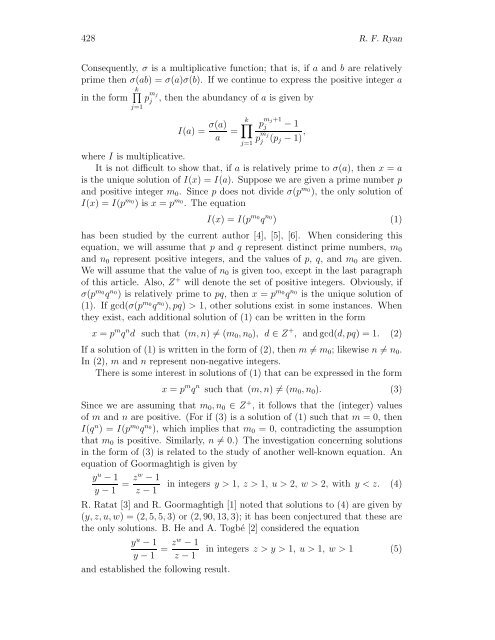An Abundancy Result for the Two Prime Power Case ... - HIKARI Ltd
An Abundancy Result for the Two Prime Power Case ... - HIKARI Ltd
An Abundancy Result for the Two Prime Power Case ... - HIKARI Ltd
You also want an ePaper? Increase the reach of your titles
YUMPU automatically turns print PDFs into web optimized ePapers that Google loves.
428 R. F. Ryan<br />
Consequently, σ is a multiplicative function; that is, if a and b are relatively<br />
prime <strong>the</strong>n σ(ab) =σ(a)σ(b). If we continue to express <strong>the</strong> positive integer a<br />
∏<br />
in <strong>the</strong> <strong>for</strong>m k p m j<br />
j , <strong>the</strong>n <strong>the</strong> abundancy of a is given by<br />
j=1<br />
I(a) = σ(a)<br />
a<br />
=<br />
k∏<br />
j=1<br />
p m j+1<br />
j − 1<br />
p m j<br />
j (p j − 1) ,<br />
where I is multiplicative.<br />
It is not difficult to show that, if a is relatively prime to σ(a), <strong>the</strong>n x = a<br />
is <strong>the</strong> unique solution of I(x) =I(a). Suppose we are given a prime number p<br />
and positive integer m 0 . Since p does not divide σ(p m 0<br />
), <strong>the</strong> only solution of<br />
I(x) =I(p m 0<br />
)isx = p m 0<br />
. The equation<br />
I(x) =I(p m 0<br />
q n 0<br />
) (1)<br />
has been studied by <strong>the</strong> current author [4], [5], [6]. When considering this<br />
equation, we will assume that p and q represent distinct prime numbers, m 0<br />
and n 0 represent positive integers, and <strong>the</strong> values of p, q, and m 0 are given.<br />
We will assume that <strong>the</strong> value of n 0 is given too, except in <strong>the</strong> last paragraph<br />
of this article. Also, Z + will denote <strong>the</strong> set of positive integers. Obviously, if<br />
σ(p m 0<br />
q n 0<br />
) is relatively prime to pq, <strong>the</strong>n x = p m 0<br />
q n 0<br />
is <strong>the</strong> unique solution of<br />
(1). If gcd(σ(p m 0<br />
q n 0<br />
),pq) > 1, o<strong>the</strong>r solutions exist in some instances. When<br />
<strong>the</strong>y exist, each additional solution of (1) can be written in <strong>the</strong> <strong>for</strong>m<br />
x = p m q n d such that (m, n) ≠(m 0 ,n 0 ), d ∈ Z + , and gcd(d, pq) =1. (2)<br />
If a solution of (1) is written in <strong>the</strong> <strong>for</strong>m of (2), <strong>the</strong>n m ≠ m 0 ; likewise n ≠ n 0 .<br />
In (2), m and n represent non-negative integers.<br />
There is some interest in solutions of (1) that can be expressed in <strong>the</strong> <strong>for</strong>m<br />
x = p m q n such that (m, n) ≠(m 0 ,n 0 ). (3)<br />
Since we are assuming that m 0 ,n 0 ∈ Z + , it follows that <strong>the</strong> (integer) values<br />
of m and n are positive. (For if (3) is a solution of (1) such that m = 0, <strong>the</strong>n<br />
I(q n )=I(p m 0<br />
q n 0<br />
), which implies that m 0 = 0, contradicting <strong>the</strong> assumption<br />
that m 0 is positive. Similarly, n ≠ 0.) The investigation concerning solutions<br />
in <strong>the</strong> <strong>for</strong>m of (3) is related to <strong>the</strong> study of ano<strong>the</strong>r well-known equation. <strong>An</strong><br />
equation of Goormaghtigh is given by<br />
y u − 1<br />
y − 1 = zw − 1<br />
in integers y>1, z>1, u>2, w>2, with yy>1, u>1, w>1 (5)<br />
z − 1<br />
and established <strong>the</strong> following result.
















